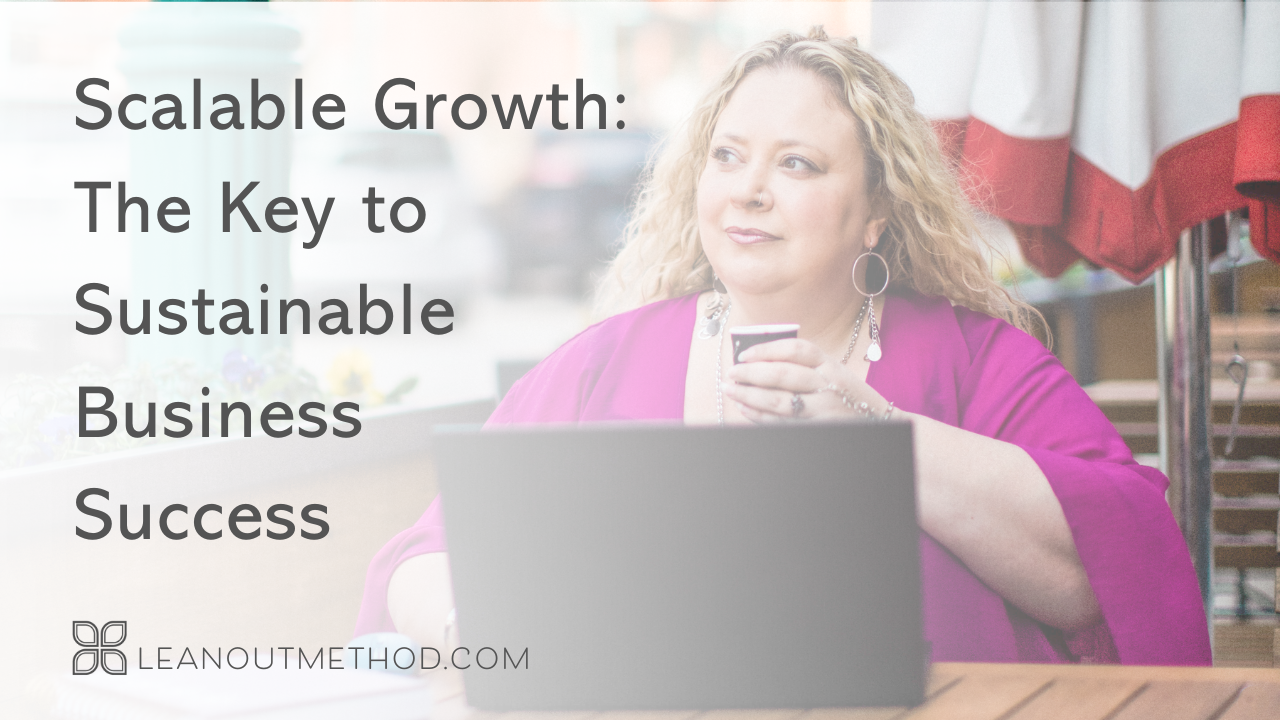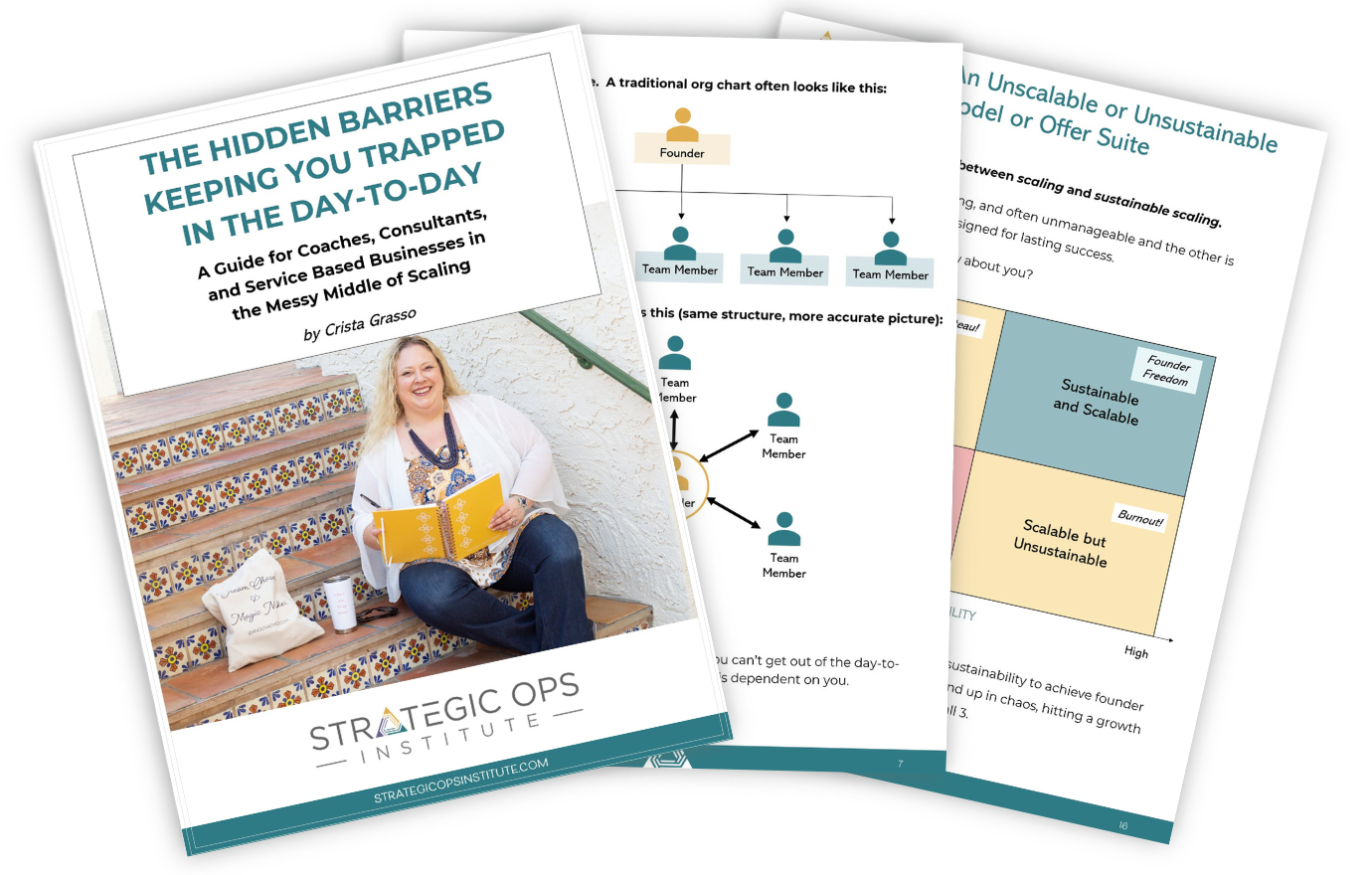
Ever wondered if the growth you’re experiencing in your business is truly sustainable, or if it's setting you up for future challenges?
Growth can be exciting, but it's often glamorized without considering the hidden chaos and complexity it can bring.
When you shift your focus from the traditional effort-driven growth model to a scalable growth model, it is like running a completely different business - one where you don't have to keep doing more or seeing profit margins shrink.
I break it down in episode 223 of the Simplify to Scale Show, where I explore how to prepare for scaling by focusing on scalable growth while you're still in the growth stage of your business.
These are the main things you need to learn to achieve scalable growth:
- The difference between effort-driven and scalable growth
- Reducing complexity and chaos caused by growth
- How to avoid common growth pitfalls
- Strategies to protect your energy and well-being
- The key shifts that make growth more sustainable
Tune into Episode 223 of the Simplify to Scale Show or keep reading below.
Understanding Growth
When we think about growing our businesses, the excitement of increasing revenue and expanding our impact often comes to mind.
Yet, there's an underlying challenge lurking beneath the surface of that growth.
This challenge can be the difference between temporary growth spurts and creating a sustainably successful business.
Let's explore how you can shift from effort-driven to scalable growth and why it matters for your business.
The Illusion of Effort-Driven Growth
Growth often gets glamorized as the pinnacle of business success, but what many don't realize is that this type of typical growth can lead to chaos and complexity.
In an effort-driven growth model, your expenses might start to rise faster than your revenue.
You bring on new team members, invest in more systems, and expand your infrastructure, yet find yourself trapped in the day to day with profitability slipping away.
Yes, growth can be exciting, but it's also misleading when the outside success doesn't match what's really going on on the inside.
Behind the scenes, it may feel like you're scrambling to keep everything together.
Many businesses try to scale from this point of chaos, not recognizing that scaling anything in that state simply amplifies existing problems.
To achieve truly sustainable growth, you need to simplify and streamline operations before scaling.

The Shift to Scalable Growth
So, how do you make that transition to scalable growth? Here’s what needs to be on your radar:
1. Simplify Your Offer Suite: Aim for a repeatable, proven system or framework.
This means moving away from reinvention every time a new client comes on board.
While personalization adds value, heavily customized models can limit scalability.
You don't have to sacrifice uniqueness but streamline where you can.
2. Shift From Being Founder-Reliant to Systems-Reliant: Your business should run efficiently through well-defined systems, not just on what's in your head.
Start by systematizing what you can, allowing you to focus on the aspects of the business that truly require your unique touch.
Over time, this reduces the dependency on you and your constant input, creating a more robust and autonomous structure.
3. Encourage Inspired Ownership: Transition from a culture of task management to one where team members own outcomes and results. This begins with clear strategic planning.
When everyone knows what success looks like and understands the business priorities, they can work more independently, moving away from a checklist mindset towards achieving meaningful goals.
Why Scalable Growth Matters
Shifting from effort-driven growth to scalable growth is not just beneficial for your business's bottom line; it significantly enhances your well-being.
Scalable growth prevents burnout by reducing the chaos and unpredictability that come with constantly reacting to issues. It provides you with:
-
Time for Visionary Work: Spend less energy on firefighting and more on driving your business forward as a leader.
-
Better Work-Life Balance: When your business isn't dependent on your constant presence, you can take breaks without a hitch.
-
Increased Profit Margins: With systems doing the heavy lifting, you can achieve more with less effort, leading to better financial outcomes.
How to Make the Transition to Scalable Growth
Many business owners find themselves in effort-driven growth because they aren't always aware that there's a better path.
Scalable growth requires intention and strategic action:
- Productize your services and structure your offers around repeatable, proven systems.
-
Build systems with intention that run to without you.
-
Hire for outcomes, not tasks.
-
Prioritize planning and adopt a 90-day strategic planning cadence.
-
Create capacity before you need it.
This doesn't happen overnight, but by focusing on systems, simplifying, and empowering your team, you set up your business for long-lasting success.
If you're working towards building a business that doesn't just look impressive from the outside but feels sustainable and rewarding from the inside, scalable growth is your answer.
Whether you're already scaling, or in the growth stage gearing up to scale, these practices will set you on the right path.
Want support determining how to shift from effort-driven growth to sustainable and scalable growth?
Download my free ebook, The Hidden Barriers Keeping You Trapped in the Day to Day.
by Crista Grasso
Crista Grasso is the go-to strategic planning expert for leading global businesses and online entrepreneurs when they want to scale. Known as the "Business Optimizer", Crista has the ability to quickly cut through noise and focus on optimizing the core things that will make the biggest impact to scale a business simply and sustainably. She specializes in helping businesses gain clarity on the most important things that will drive maximum value for their clients and maximum profits for their business. She is the creator of the Lean Out Method, 90 Day Lean Out Planner, and host of the Lean Out Your Business Podcast.





